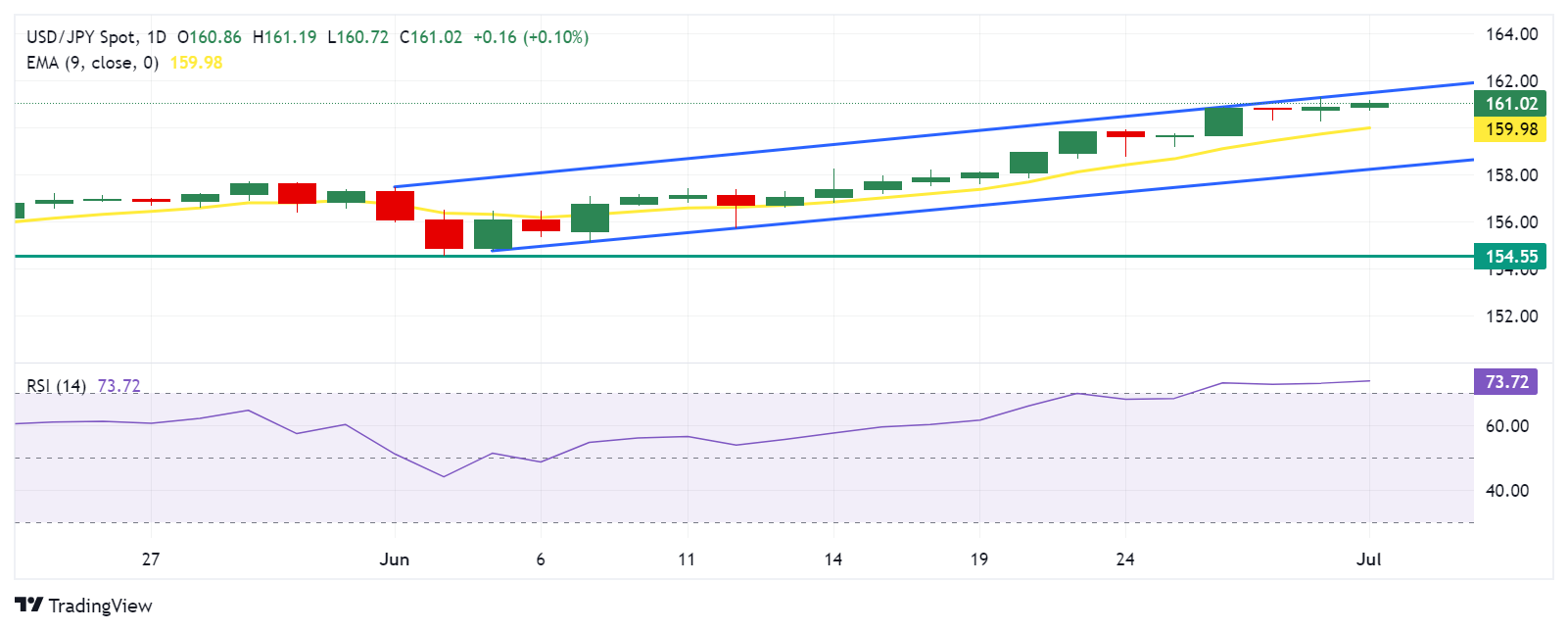- The Japanese yen is holding around its 38-year low of 161.28.
- The JPY may limit its decline as the Tankan Large Enterprise Manufacturing Index rose to 13 in the second quarter, reaching the highest level in two years.
- US Dollar Struggles as Recent Inflation Data Raises Expectations of Fed Rate Cuts in 2024.
The Japanese Yen (JPY) remains tepid on Monday near its lowest level of 161.28 since 1986. However, its decline appears limited as upbeat business confidence data from Japan lifted market sentiment. Furthermore, expected speculation about imminent intervention by Japanese authorities supports the JPY.
Japan’s Tankan Large Manufacturers Index rose to 13 in the second quarter from the previous reading of 11. The index hit the highest level in two years amid an improving economic outlook. Meanwhile, Japan’s Jibun Bank Manufacturing PMI for June was revised slightly down to 50 from a preliminary reading of 50.1, but remained expanding for the second straight month.
The US Dollar (USD) depreciates as recent inflation data raises expectations that the US Federal Reserve (Fed) will cut interest rates in 2024. CME FedWatch tool indicates the likelihood of a cut The Fed’s December rate target of 25 basis points has risen to nearly 32.0%, up from 28.7% a week earlier.
Daily Digest Market Movers: Japanese Yen Falls Despite Upbeat Business Confidence Data
- The outlook for Japan’s Tankan Large Manufacturing Index rose to 14 in the second quarter from the previous reading of 10. Meanwhile, All Large Industry Capex rose to 11.1% in the second quarter from 4.0% former.
- On Friday, San Francisco Federal Reserve Bank President Mary Daly said monetary policy is working. Still, it’s too early to say when it will be appropriate to cut interest rates. Daly said, “If inflation remains persistent or declines slowly, rates would need to be higher for longer,” according to Reuters.
- On Friday, the US Bureau of Economic Analysis reported that US inflation slowed to its lowest annual rate in more than three years. The US Personal Consumption Expenditure (PCE) Price Index rose 2.6% year-over-year in May, up from 2.7% in April, meeting market expectations. Core PCE inflation also rose 2.6% year-over-year in May, up from 2.8% in April, in line with estimates.
- Reuters reported on Friday that Japanese Finance Minister Shunichi Suzuki said authorities were “deeply concerned” about the impact of “rapid and unilateral” currency exchange moves on the economy. Suzuki added that excessive volatility in the currency market is undesirable and that authorities will respond appropriately to such movements.
- On Friday, data showed that Tokyo’s Consumer Price Index (CPI) inflation rose to 2.3% year-on-year in June, up from 2.2% in the previous period. Tokyo’s core CPI inflation, which excludes volatile food prices, also rose over the same period, reaching 2.1% year-on-year compared with 1.9% previously, beating the median market forecast of 2.0% year-on-year.
Technical Analysis: USD/JPY is around 161.00
USD/JPY is trading around 161.00 on Monday. Analysis of the daily chart shows a bullish bias, with the pair hovering near the upper boundary of an ascending channel pattern. The 14-day Relative Strength Index (RSI) is positioned above the 50 level, indicating bullish momentum.
Breaking above the upper boundary of the ascending channel pattern around 161.50 will reinforce the bullish sentiment, potentially pushing the USD/JPY pair towards the psychological level of 162.00.
On the downside, immediate support appears at the nine-day exponential moving average (EMA) at 159.98. A break below this level could intensify the bearish pressure on the USD/JPY pair, potentially taking it towards the lower boundary of the ascending channel around 158.20. A break below this level could push the pair to test the June low at 154.55.
USD/JPY: Daily Chart
Japanese Yen PRICE Today
The table below shows the Japanese Yen (JPY) exchange rate against major currencies today. The Japanese Yen was the weakest currency against the Euro.
| USD | EUR | GBP | JPY | CAD | AUD | NZD | CHF | |
|---|---|---|---|---|---|---|---|---|
| USD | -0.39% | -0.09% | 0.19% | 0.02% | 0.06% | -0.03% | 0.15% | |
| EUR | 0.39% | 0.07% | 0.28% | 0.10% | 0.34% | 0.06% | 0.24% | |
| GBP | 0.09% | -0.07% | 0.20% | 0.04% | 0.29% | -0.02% | 0.17% | |
| JPY | -0.19% | -0.28% | -0.20% | -0.17% | -0.07% | -0.22% | -0.01% | |
| CAD | -0.02% | -0.10% | -0.04% | 0.17% | 0.08% | -0.05% | 0.13% | |
| AUD | -0.06% | -0.34% | -0.29% | 0.07% | -0.08% | -0.28% | -0.02% | |
| NZD | 0.03% | -0.06% | 0.02% | 0.22% | 0.05% | 0.28% | 0.20% | |
| CHF | -0.15% | -0.24% | -0.17% | 0.01% | -0.13% | 0.02% | -0.20% |
The heat map shows percentage changes for major currencies. The base currency is selected from the left column, while the quote currency is selected from the top row. For example, if you choose the Japanese Yen from the left column and move along the horizontal line to the US Dollar, the percentage change shown in the box will represent the JPY (base)/USD (quote).
economic indicator
Prices of business services (YoY)
He Bank of Japan publishes this estimate of the change in the prices of the services offered between the different firms. It indicates the development of prices, which reflects the conditions of supply and demand in the service market. It is also considered an indicator of inflationary pressures. A reading above the market consensus is bullish for the yen, while a reading below expectations is bearish.
Source: Fx Street
I am Joshua Winder, a senior-level journalist and editor at World Stock Market. I specialize in covering news related to the stock market and economic trends. With more than 8 years of experience in this field, I have become an expert in financial reporting.








